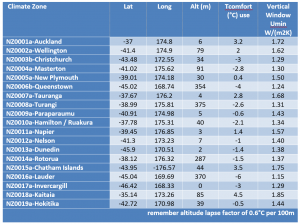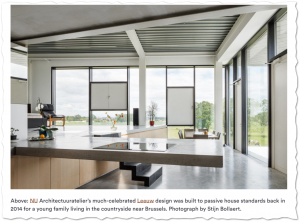I’ve been asked about improving the performance of larger buildings. This often requires an external insulation facade solution but getting it right is not always obvious. I’m a fan of timber. But if you are retrofitting a concrete, steel or brick building, continuous external insulation is one way to improve performance. This can be done with external foam insulation and …
New design choices possible in Queenstown and Wellington

Thermal comfort targets have been revised by the Passive House Institute for use in PHPP. Passive House certification requires that windows and doors meet specified thermal comfort targets*. This requirement ensures people inside Passive Houses will enjoy comfortable temperatures everywhere, even if sitting right next to a window in the middle of winter. I became aware some time back that …
Attend the North American PH conference virtually

The North American Passive House Network annual conference will be a great event—and way cheaper than normal due to being virtual. The bad news is the timing sucks for Australia and New Zealand time zones if you want to chat with the speakers live. However, all the recordings will be available to registered participants for later viewing. All the details …
Owl Woods PH nails a design-stage retrofit for performance

Check out a beautiful project from across the Tasman, the Owl Woods Passive House. It’s the 10th certified Passive House in Victoria, Australia and it’s won or still a finalist for a host of design and sustainability awards. Check out photos here; there are even a few construction photos, which are always my favourites. The Passive House Database entry will satisfy …
Great Passive House primer (includes eye candy and clear diagrams!)

This is a lovely summary of Passive House, written up as a Q&A with an American architect. There’s mention of an intriguing North American connection to the genesis of Passive House which you may not be aware of, some appealing images of various Passive Houses (I’m loving the Brussels home) plus some excellent diagrams illustrating the five basic principles. All …
Passive House (Passivhaus) Hospitals

Passive House Hospitals can have a 40-50% reduction in total energy use of the building, using efficient technologies already available, when compared to a conventional new hospital building. I’ve been encouraged by questions from various health boards and government here in NZ to provide information and connect them to the designers of the Passive House Hospital in Frankfurt (Passive House …
uPVC joinery worth another look

Clients (and their designers) who want high-performance buildings on a limited budget need to consider uPVC windows. Elsewhere, almost every Passive House on a budget will use uPVC joinery, typically white inside and out to maximise performance and minimise cost. Note though that uPVC windows are also available with an aluminium cladding on the exterior face to allow a choice …
Airtightness, explained (plus, see blower doors in action)

Check out these helpful instructional videos on airtightness and air leakage testing. Made in Australia, the general observations about lack of awareness of the importance of airtightness apply here too. This series of three short videos (less than seven minutes each) is produced by Efficiency Matrix, a supplier of products and testings for airtightness. The first video is absolutely worth …
Need more than just higher performance building code changes to decarbonize

“In buildings, it has become clear that there are two very distinct problems. One concerns new buildings — where, for example, advanced heat pump technology can allow for electrification of heating systems. The other, much bigger problem is how to cut emissions from existing buildings, which will account for most emissions from this sector. Here the actions are a blend …

